2.1 Introducing the Brain
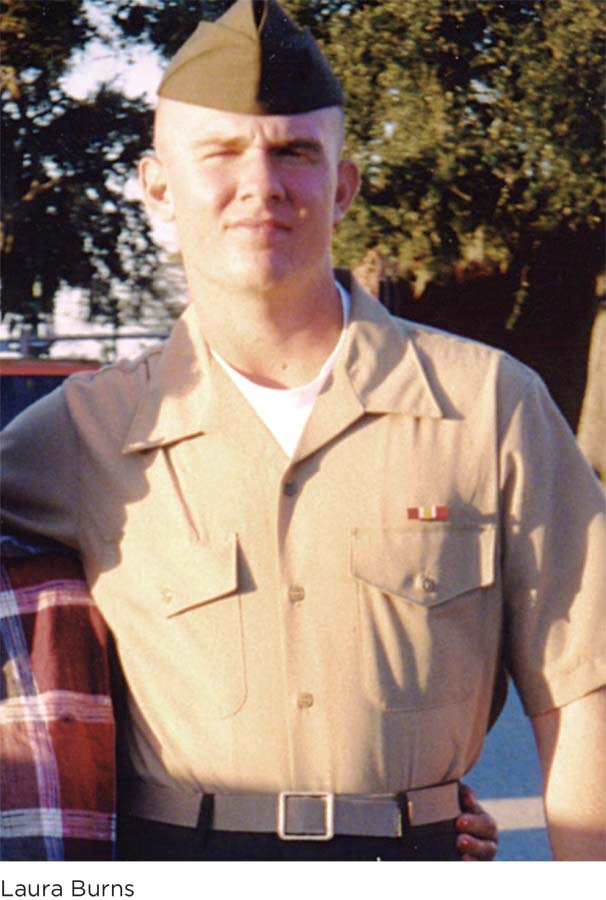
Brandon Burns poses for a photo at the Marine Corps Recruit Depot in Parris Island, South Carolina, in the fall of 2003. The following year, he was shot by an enemy sniper in the battle of Fallujah.
IN THE LINE OF FIRE It was November 9th, 2004, and U.S. Marine Brandon Burns was surrounded on all sides by gunfire. The enemy was everywhere, in the buildings, streets, and alleyways of Fallujah. “I was in the deepest part of the city [and] there was chaos,” remembers Brandon. At age 19, Brandon was on the front lines in the Iraq War, fighting in the battle of Fallujah.
“I was on top of the Humvee automatic grenade launcher shooting round after round,” Brandon recalls. Suddenly, there was darkness. A bullet from an enemy sniper had pierced Brandon’s helmet and skull, and ricocheted through the back left side of his brain. Bleeding and unconscious, Brandon was rushed from Fallujah to Baghdad. Medics had to resuscitate him on five separate occasions during that ambulance ride. Brandon explains, “Five times I died.”
From Baghdad, Brandon was transferred to a hospital in Germany. Doctors concluded that some parts of his brain were no longer viable. “They removed part of my skull and dug out the injured part of my brain,” and now, Brandon says, “one third of my brain is gone.” 

At the age of 17, Brandon signed up to join the Marines. Two years later, he found himself engaged in some of the most rigorous urban combat of the Iraq War (Filkins, 2004, November 21).
Note: Quotations attributed to Brandon Burns, Laura Burns, and Christina Santhouse are personal communications.
LEARNING OBJECTIVES After reading and studying this chapter, you should be able to:
LEARNING OBJECTIVES After reading and studying this chapter, you should be able to:
LO 1 Define neuroscience and biological psychology and explain their contributions to our understanding of behavior.
LO 2 Compare and contrast tools scientists use to study the brain.
LO 3 Label the parts of a neuron and describe an action potential.
LO 4 Illustrate how neurons communicate with each other.
LO 5 List various neurotransmitters and summarize their involvement in human behavior.
LO 6 Explain how the central and peripheral nervous systems connect.
LO 7 Describe the organization and function of the peripheral nervous system.
LO 8 Summarize the role of the endocrine system and how it influences behavior.
LO 9 Describe the two brain hemispheres and how they communicate.
LO 10 Explain lateralization and how split-
LO 11 Identify areas in the brain responsible for language production and comprehension.
LO 12 Define neuroplasticity and recognize when it is evident in the brain.
LO 13 Identify the lobes of the cortex and explain their functions.
LO 14 Describe the association areas and identify their functions.
LO 15 Distinguish the structures and functions of the limbic system.
LO 16 Distinguish the structures and functions of the brainstem and cerebellum.
A Complex Communication Network
Imagine that you lost a sizable chunk of your brain. How would it impact your life? Would you be the same person as before? Your brain houses your thoughts, emotions, and personality, and orchestrates your behavior. It files away all your memories and dark secrets, and is involved in your every move, from the beat of your heart to the blink of your eye.
However, the human brain is only one part of the most complex living entity known. The human nervous system is a communication network that conveys messages throughout your body, using electrical and chemical processes. The nervous system contains the brain, spinal cord, and other nerves and fibers, and includes some 100 billion (1011) nerve cells. For a sense of what that number represents, consider that the population of the United States was approximately 320 million people in 2015; the number of nerve cells is approximately 313 times the number of people living in the United States. These cells are interlinked through some 100 quadrillion (1015) connections (Tang, Nyengaard, De Groot, & Gundersen, 2001). This intricate, ever-
Consider the many tasks your brain is juggling at this very moment. As you scan the words on this page, your brain helps control the tiny muscles moving your eyes back and forth as well as the larger muscles in your neck and torso that keep you sitting upright. Light-
The Last Frontier: From Bumps to Brain Scans
Synonyms
biological psychology biopsychology, psychobiology, neuropsychology, physiological psychology, behavioral neuroscience
LO 1 Define neuroscience and biological psychology and explain their contributions to our understanding of behavior.
neuroscience The study of the brain and nervous system.
biological psychology The branch of psychology that focuses on how the brain and other biological systems influence human behavior.
Brandon’s injury resulted in a significant loss of his brain tissue. Remarkably, not only did he survive, but he can still talk about what occurred, think about the events, and feel emotions regarding what happened to him. How exactly does his brain orchestrate all these complex functions, especially after severe trauma? And how does a noninjured brain carry out these complicated processes? Scientists have developed a decent understanding of how individual brain cells communicate with each other, but they have yet to provide definitive answers to “big questions” involving the brain and other parts of the nervous system such as: How do we think? What is consciousness? Why must we sleep? This is why the brain may be regarded as the last frontier of medicine. Neuroscience, the study of the brain and nervous system, actually extends far beyond the borders of medicine and into disciplines as diverse as engineering, computer science, and our personal favorite—
CONNECTIONS
In Chapter 1, we presented the four major goals of psychology, which are to describe, explain, predict, and control behavior. These four goals guide psychologists’ investigations of how biology influences behavior. As you read through this chapter, try to keep these goals in mind.
LO 2 Compare and contrast tools scientists use to study the brain.
Brandon underwent many brain scans before and after his surgeries, which allowed doctors to get a detailed look inside his head without lifting a scalpel. But had Brandon lived in a different era, brain scans would not have been an option.
phrenology An early approach to explaining the functions of the brain by trying to link the physical structure of the skull with a variety of characteristics.
Before there were technologies to study the brain, people could only speculate about what was going on beneath the skull of a living person. One theory was that bumps on a person’s skull could reveal characteristics about him. Judging the topography of a person’s head was a core part of phrenology, the now discredited brain “science” that achieved enormous popularity at the beginning of the 19th century through its founder Franz Joseph Gall (1757–
CONNECTIONS
If phrenology were practiced today, we would consider it a pseudoscience, or an activity that resembles science but is not supported by objective evidence. (See Chapter 1 to read more on pseudoscience.)
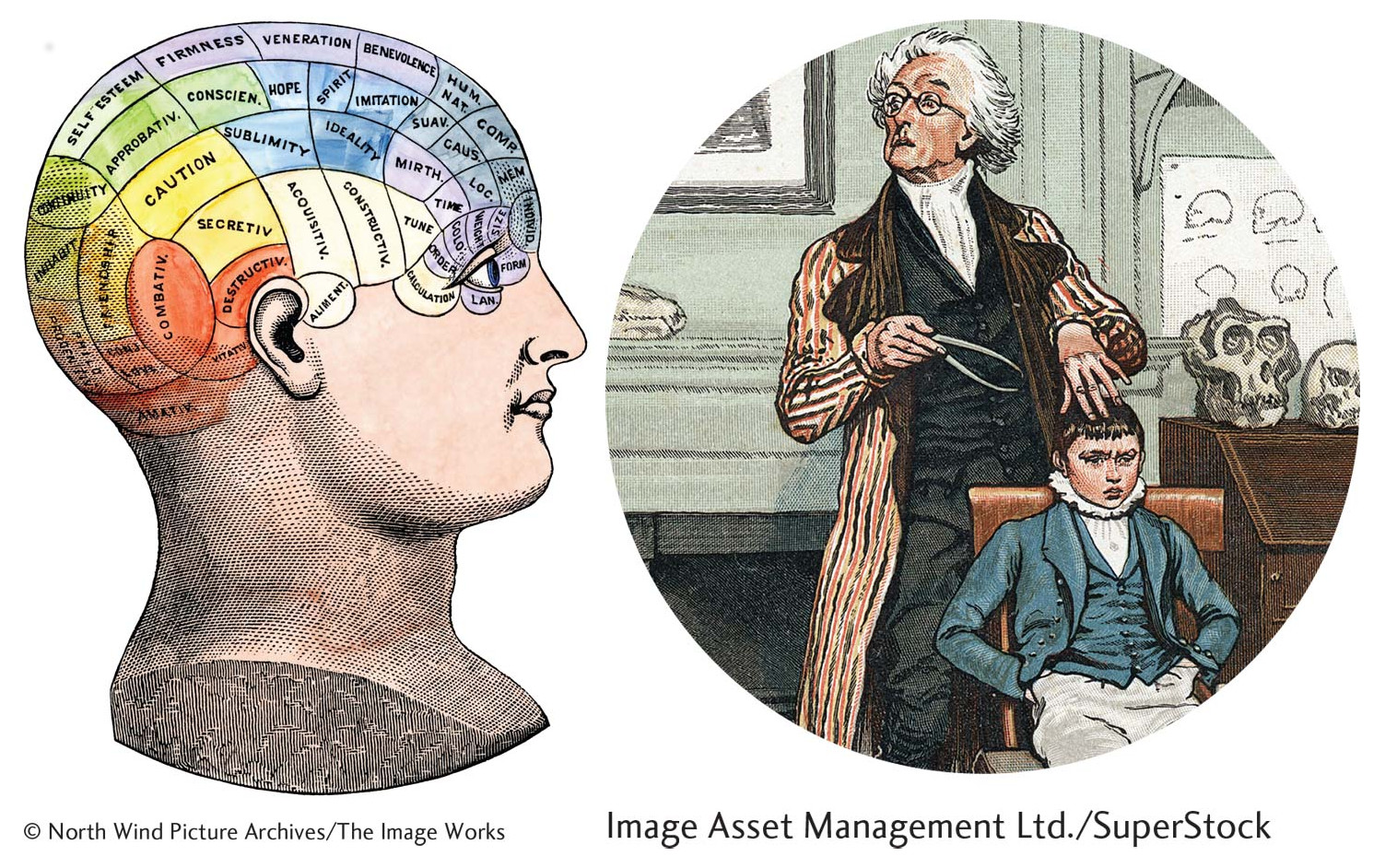
Are you a secretive person? How high is your self-
Brain research has come a long way since the days of Gall and Flourens. The last century, and particularly the last few decades, has witnessed an explosion of technologies for studying the nervous system (see Infographic 2.1 below). Such advances have made it possible to observe the brain as it makes decisions, sleeps, and even tells lies (Dang-
INFOGRAPHIC 2.1
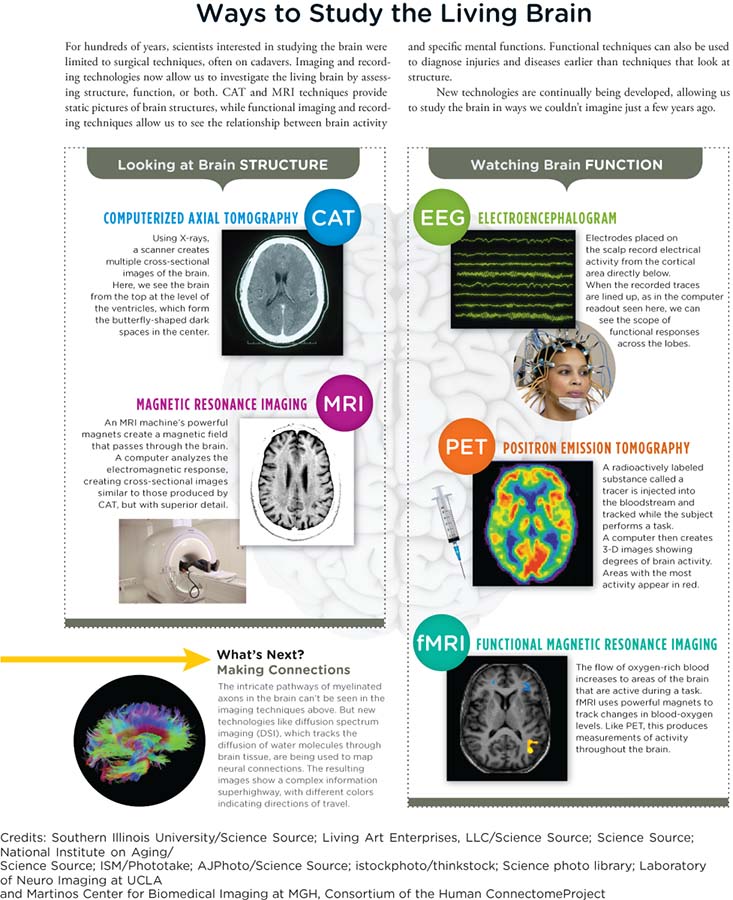
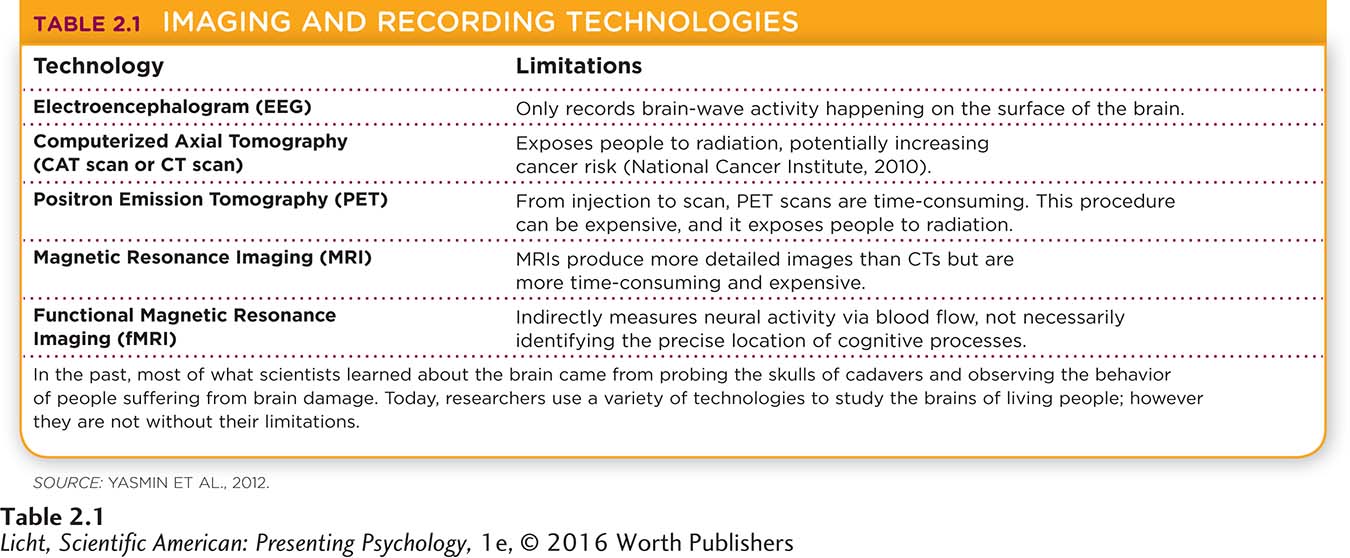
neurons The building blocks of the nervous system that transmit electrical and chemical signals in the body.
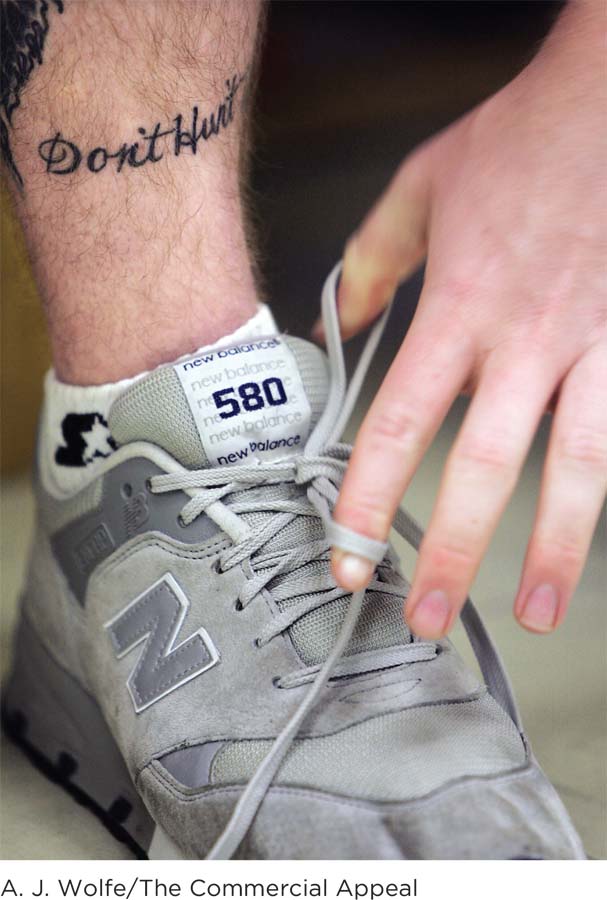
Brandon ties his shoelaces with his left hand. His traumatic brain injury occurred on the left side of his brain, causing paralysis and loss of sensation on the right side of his body.
With that overview, we are now ready to begin our chapter-
 THE AWAKENING Two weeks after the shooting, Brandon finally awoke from his coma. He could not move or feel the right side of his body, and he had lost the ability to use language. There were so many things he wanted to say to his family, but when he opened his mouth, the only sound that came out was “ugh.” Weeks went by before Brandon uttered his first word: “no.” That was all he could say for months, even when he was dying to say “yes.”
THE AWAKENING Two weeks after the shooting, Brandon finally awoke from his coma. He could not move or feel the right side of his body, and he had lost the ability to use language. There were so many things he wanted to say to his family, but when he opened his mouth, the only sound that came out was “ugh.” Weeks went by before Brandon uttered his first word: “no.” That was all he could say for months, even when he was dying to say “yes.”
Apart from the paralysis to his right side and his difficulty with language, Brandon’s other abilities appeared to be intact. He could remember people, places, and objects, and he reported no trouble hearing, smelling, or tasting. Although Brandon was not as outgoing and self-
Why did the trauma to Brandon’s brain cause deficits in language, but not memory? Why was the right side of his body paralyzed, while the left side worked fine? Our discussion of the brain’s organization later in this chapter will clear up these mysteries for you. But first, let’s find out how neurons in the brain and body communicate, for this biological process underlies your every behavior, thought, and emotion. 
show what you know
Question 1
1. Made up of the brain, spinal cord, and other nerves, ____________ is a communication network that conveys messages throughout the body, using electrical and chemical processes.
consciousness
the human nervous system
a neuron
the skull
b. the human nervous system
Question 2
2. A researcher studying the impact of Brandon’s brain injury might work in the field of ____________, which includes the study of the brain and nervous system.
neuroscience
Question 3
3. In the next section, you will learn much more about neurons, which are often referred to as the “building blocks” of the nervous system. What building blocks are you familiar with in other fields of study?
Answers will vary. Building blocks can include items ranging from flour and butter in culinary training to numbers in mathematics. Atoms, chemical compounds, mechanical parts, and many other basic components may be building blocks in other fields of study.